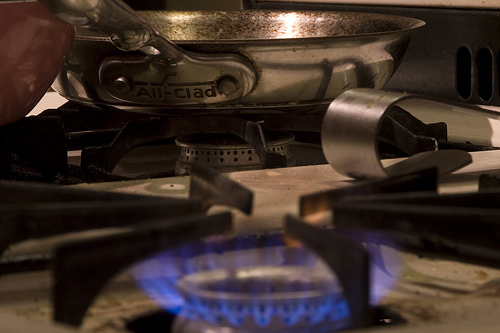![]() photo credit: foodiesathome.com
photo credit: foodiesathome.com
Frequent Contributor Peggy Webb offers another great article, part of our Wellness series…
Natural Healing for Kitchen Burns
by Guest Blogger, Peggy Webb, Local Nourishment blog
I’m a bit of a klutz in the kitchen, and the earlier the morning or the fewer hours of sleep, the worse I get! As you can imagine, breakfast is the most dangerous meal of the day for me. But I’ve developed some coping strategies I thought I’d share with you this week.
First, a bit of terminology. A first-degree burn is like a sunburn. It is red and can have white splotches or hard patches and is accompanied by minor pain. These are also called superficial thickness burns.
Second-degree burns include blistering and can cause quite a bit of pain if the burn involves nerve tissue as well as skin tissue. These can also be called superficial partial-thickness burns.
If the skin is blackened and charred or crusted, this is generally considered a third-degree, or deep partial-thickness, burn. This kind of burn results in reduced sensation in the area, as nerve tissues are damaged beyond their ability to transmit pain messages.
Full-thickness burns include damage down to the muscle and bone and require skin grafts.
Though there are also chemical, electrical, and radiation burns, I will only deal here with steam and scalding burns, as these are the most frequent kind encountered in a real-food kitchen. As always, please see a doctor for severe burns, burns that cover a large part of the body, or injuries to the very young or very old, as their thin skin can be permanently damaged much more easily.
The first thing we experience when getting burned is, of course, PAIN! Rush to the kitchen sink and run a gentle stream of cool water over the burned area. You will probably notice the burn feels better under cool water and worse within seconds of removing it from the water.
Do not reach for the butter, ice, or even aloe in these early moments. Oils trap heat on the surface of the skin and can allow the burn to penetrate for a much longer time, while ice can stick to already damaged skin and tear it, injuring it further.
If the burn is on a fingertip, fill a coffee cup with water and soak the injury. I find a 20-minute soak lets me remove my finger for several minutes before the pain returns. As long as the burned area is relatively small, cool water offers your best hope of relief. If the burn covers a large area—like a sunburn might—soak in a cool tub no more than 20 minutes, as hypothermia can be a dangerous side effect of burning. For larger areas or body parts that can’t fit into a soaking bowl, like the middle of your arm or leg, you can use a wet compress over the area.
This method of immediate cooling can reduce the severity of burns by a degree. In other words, burns that would have blistered may only turn red, whereas burns that would have remained red may heal in just hours. Burns need fresh air to heal quickly, so unless the burn is oozing (which makes it a more serious burn capable of becoming infected) it should not be covered.
After several hours, apply the pure gel from the inside of an aloe vera plant leaf. Please do not use aloe vera gel from a bottle that has preservatives or other additives, as burnt skin is very delicate and easily injured.
Other herbal remedies include St. John’s wort herb oil or calendula salve. Look to the refrigerator as well—mashed avocado is very soothing and healing, and coconut oil has both healing and anti-microbial properties. But be sure the burn is completely cooled before applying anything other than cool water to a burn.
One of the few over-the-counter products I keep in my first-aid kit is a burn pad. It’s made of plastic and contains water held in a base of polyethylene oxide. The gel sheet holds water up against the burn, which provides both pain relief and hydration for the parched skin. The plastic itself is LDPE, recycle number 4, which does not contain BPA and is not known to leach any chemicals or hormone disruptors. However, because the pads contain polyethylene oxide, a known carcinogen, and because damaged skin more readily absorbs synthetic chemicals than healthy skin, I prefer to use these products on the rare occasion that a cool-water soak or wet compress is not possible.
Peggy Webb is a homemaker, mom of six and blogger. She’s not a doctor, nutritionist or other health care professional, just a student nutrition and herbal health. Her articles are not to be construed as medical advice. Please consult your own trusted healthcare professionals about your concerns and questions. Visit Peggy’s blog at LocalNourishment.org.




Thanks for these great tips! I think I need to get an aloe plant. 🙂
.-= Laryssa @ Heaven In The Home´s last blog ..Reusable Canning Jar Lids-Giveaway! =-.
You left off one of the BEST home burn remedies: banana peel. IDK what it is, but the inside of a freshly peeled banana works better than anything else I’ve tried. After a while, you may need to replace it with fresh peel, but it really is the absolute best. Aloe will help it heal up fast too (best when combined w/ vitamin E), but it does not take away the pain as well as the banana.
Natalie, it IS the BEST home remedy for burns. I’ve tried a lot of the other remedies mentioned over the years, and banana peel is the ONLY thing that works for me. I filled my zippo lighter today and put it in my jeans pocket…after about 15 minutes, my leg started burning. I googled this, and sure enough, you can get a burn from the lighter fluid from a freshly filled zippo..(who knew?). It’s called a chemical burn…..Anyway, I peeled a banana and put the peel on my new burn..and in a half hour, it’s FINE. It’s a bit pink, but the pain is gone. I SWEAR by this treatment for burns, and I tell everyone about it.
Natalie, I’ve never, ever heard of that! How exciting! Off to research…
.-= Local Nourishment´s last blog ..Get the heat out! =-.
It is always good to hear what experiences work for others, and I can attest that the aloe vera plant gel and juice have worked for me. I generally use coconut oil on burns later after they have started healing, but for household burns on stoves and ovens, and sunburns, cool water and vinegar also helps - and apply the healthy oil later. Thanks for this article!
.-= Raine Saunders´s last blog ..Common Myths About Food & Nutrition =-.
I have two great remedies for kitchen burns. First, I use 3% food-grade hydrogen
peroxide in my home for multiple uses. In the kitchen, I keep a small spray bottle
with a mixture of 3% HP and several drops of essential oil of lavender. This gives
INSTANT relief.
Second, I keep a bottle of essential oil of lavender in the refrigerator. Lavender was used in hospitals in the 1800’s for anti-bacterial properties and healing. It was discovered to help heal burns by a French during that time.
My hubbie was helping in the kitchen this morning and burned himself on a hot plate. I need to get some of this lavender spray right away!!
We always use apple cider vinegar - the cheap kind works fine. Soak a paper towel and wrap it around the burn, leave on at least 20 minutes. I never get blisters or scars or anything since I started using ACV.
An herbalist at our farmers market made me a custom “cooling spray” suitable for minor burns and sunburn. It has aloe, calundula, and lavender.
This blog post is inspiring product design!
All you herbalists out there, take note, there is a big market for products like this for traditional foodies.
Kimberly
Our web site provide you with lots of home remedies that can be made at home using simple ingredients to make cure your burns. Visit our site to follow more on coping up with healing burns.
Hi,
Kitchen burn is the problem that is faced by women for the most of the time. It can be happen in a day many times. So in spite of go to doctor we can use our natural home treatment and remedies.
Im going to remember this next time i get burnt in the kitchen, which im sure is not far from now. Thanks much.
I know, I burnt myself twice yesterday!
I found that if you can stand the pain, do not run it under cold water it will blister. I found that putting cinnamon on the burn keeps it from scarring and blistering. As a test (not intentional mind you) I had a hot water burn on the palm of my hand and I put on one half cinnamon and the rest I left alone. Within a few hours I could tell where I had the cinnamon line. There was no burn on the cinnamon side and on the other side was red and painful for a week. I got this tip from a Civil War reenactor.
At work in a deli and grill we use just mustard, it takes away the pain. I’ve use it many times.